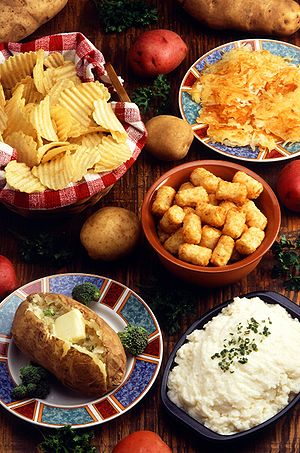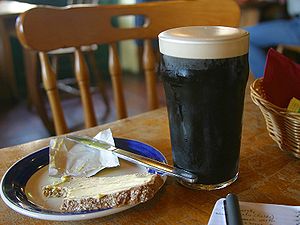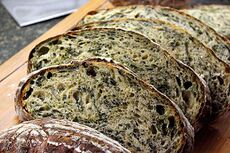Kiravian cuisine
In this era of "molecular gastronomy" it has become fashionable to claim that fine cooking can be rationalised into a sort of science. In most parts of the world, this is of course preposterous. Kiravian cuisine, however, can be easily boiled down - pardon the pun - to gradeschool arithmetic. In 21203 years all they have managed to come up with is a dozen or so different ways to combine potatoes with meat and a savoury green that pair well with a beer. I will not waste any more breath discussing it.
— Antoine Lebâtard, Plates Uncharted, S3 E6 - "Vomiting in Valēka"



 |
 |
 |
 |
 |
 |
Ingredients
Potato
Other Root Vegetables
Cereals & Pseudocereals
Forestry Products
Fruits of the Sea
Among most Coscivian peoples, the flesh of whales and other cetaceans is considered taboo, a proscription associated with Sarostivism and ancient Coscivian selenolatry. This taboo was not observed by the Eshavians or the Lúnstans, and was widely violated by the Svéaran Kir.
Fungi
Edible fungi are an extremely important protein source in the Kiravian diet.
Mushroom ketchup is a standard condiment available at most Kiravian restaurants. Although the gap has narrowed over time, mushroom ketchup remains slightly more popular than tomato ketchup introduced from Urcea, which some Kiravians find too sweet for their liking.
Algæ
Meats
For most of recorded Kiravian history, swine were the primary source of meat. Pork and pork products remain the most widely consumed form of meat in the country (fish and fowl excluded), though beef has been steadily gaining ground since the end of Kirosocialism.
A pygmy dog breed known in Ænglish as the Kirish game hound is raised for meat, mainly in the interior and parts of the Baylands. Dogmeat was historically regarded as poor man's fare, but has recently undergone something of a lobster effect and become fashionable among the élite. Consumption of dogmeat was on the decline for much of the modern era, but rapidly expanded during the latter half of the Kirosocialist period due to food scarcity caused by the command economy. As dogs were outside the scope of government planning and not regulated as livestock, they could be raised for sale on the black market without fear of criminal penalty. Contemporary production is mainly for the domestic market, due to low foreign demand and legal prohibitions in many countries.
Poultry
Cooking techniques
Boiling
Boiling and simmering have always been essential techniques in Kiravian cooking, given the wet, wooded environment of much of Great Kirav and Kiravians' heavy reliance on hard root vegetables.
Grilling
Baking with Additives
In the supratemperate and boreal regions of Great Kirav where cereal cultivation was often unreliable in premodern times, the use of various additives to stretch bread flour became a common practice. Though principally employed during grain shortages, some such additives were incorporated into ordinary cuisine. In the nemoral belt, acorn flour was the flour additive of first resort. Tree flour was very commonly used, and in Upper Kirav, Koskenkorva, and the Northeast Highlands (especially the Goidelic Forest), tree flour made from the cambium of the Fiannrian pine is still added to flatbreads, pancakes, and porridges. Tree flour was extremely common during the Kiravian Union, when shortages of grain flour and potato flour were frequent and the timber-processing camps of the state katergon system provided ample quantities of delicious, nutritious‡ sawdust. In coastal regions, various forms of seaweed are added to bread dough, even in times of plenty and still popular in modern times. These kelp breads are most strongly associated with Farravonia, Eusa, and the Cronan colonies, especially Atrassica and Kiravian Cusinaut.
Hallmark dishes
Xákuv (Hashes)
The xákuv, translated as "hash", is a diverse and ubiquitous class of dishes comprising sliced, diced, or chopped potato mixed with other ingredients and seasonings and pan-fried together. Similar dishes exist in Levantia and the Levantine diaspora, where they are considered a breakfast item. In Kiravia, however, there are xákuv fit for all meals of the day. A simple xákuv includes - in addition to the potato base - diced vegetables (onions, leeks, scallions, and peppers being the most common) and mushrooms, meat or fish, and seasonings (salt, at a minimum). However, xákuv recipes can be much more complex, incorporating multiple protein sources and additional ingredients such as eggs, congealed grain porridge, sauces, and even melted cheese. Traditionally, as with soups and stews, homemade hashes were (and are) often eclectic, making use of disparate scraps and leftovers.
The official territorial dish of Seváronsa is a "Polynesian hash" that incorporates pork and pineapple as primary ingredients. Similar tropical variations on xákuv are widely served in Sarolasta and Saint Kennera-Pribraltar.
Canova Bag - Coarse hash, diced fried chicken (usually breaded), chili powder, fried onions, hot green chilis.
Metrea Classic - Medium hash, diced or ground bacon, diced avocado and tomato, molten Metrea jack.
Æonara Classic - Fine or medium hash, bell peppers, and onions.
Kilikas White - Fine hash, whitefish, diced hard-boiled egg, coarse sea salt.
As xákuv is easy to prepare and keep warm for extended periods, it has been peddled by street vendors for millennia. Modern xákuv carts and stationary xákuv buffets offer a suite of common hot ingredients that can be stirred into the hash according to the customer's taste. Pre-mixed and even pre-cooked canned hashes can now be bought in supermarkets.
Kiravian Tacos
The much-beloved taco found its way to Kiravian shores through enduring commercial ties to Takatta Loa. There are two main nativised forms of the taco in Great Kirav: Northern-style tacos that use a sourdough rye or Coscivian cuckwheat crêpe as the base, and Southern-style tacos that use a wheat flatbread. Northern tacos come in both hard- and soft-shelled forms, while Southern tacos are customarily soft-shelled. In both regions, fish, crabmeat, and shrimp are the most common filling, and crab seasoning is commonly added to enhance flavour. Southern-style tacos may also be filled with devilled ham. In Niyaska, there is a northern-style variant filled with shredded tuna, hot peppers, and capers. Æonarans, Krasoa Islanders, and Pribraltarians eat tacos that more closely resemble the original Loa varieties.
Boiled Greens
The shoots and leaves of various cruciferous vegetables widely grown in Great Kirav - collard, peppergrass, turnip, mustard, watercress, upland cress, radish, and of course, cabbage - are boiled, producing a delicious, nutrient-rich broth that is further fortified with salt, pepper, and cured or smoked pork or turkey. The greens and broth can be consumed either together or separately, and in both forms are a cherished Kiravian dish regarded as both a s peasant food and comfort food.